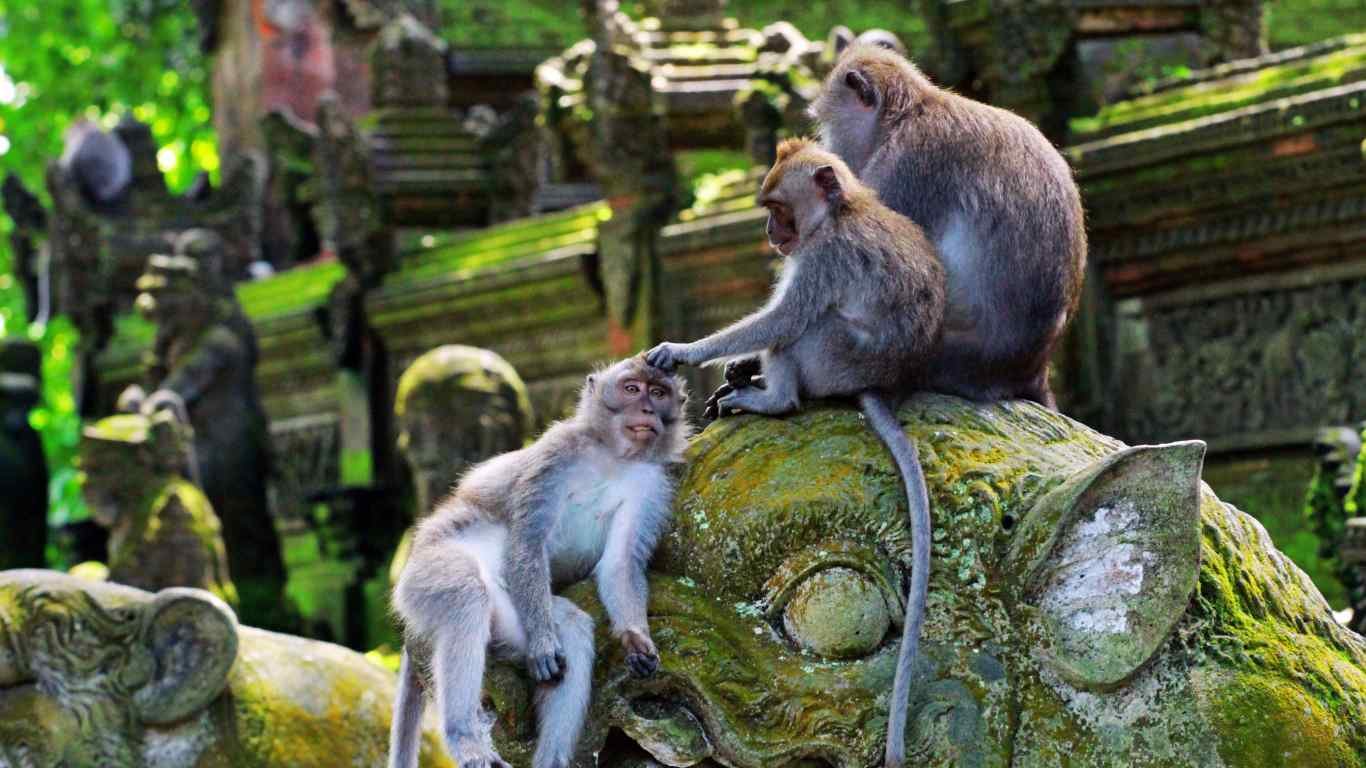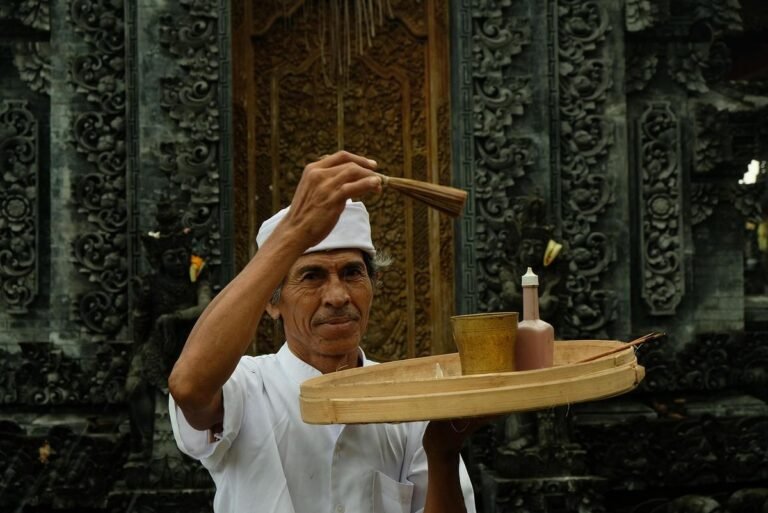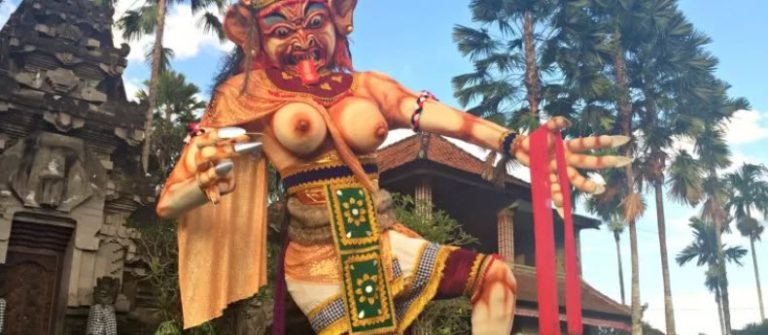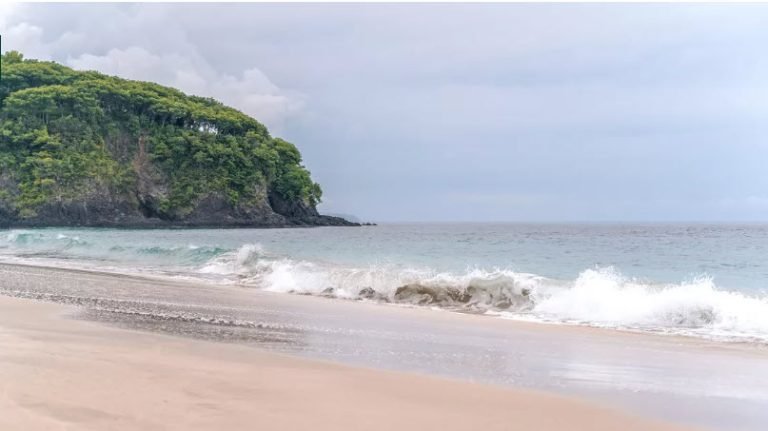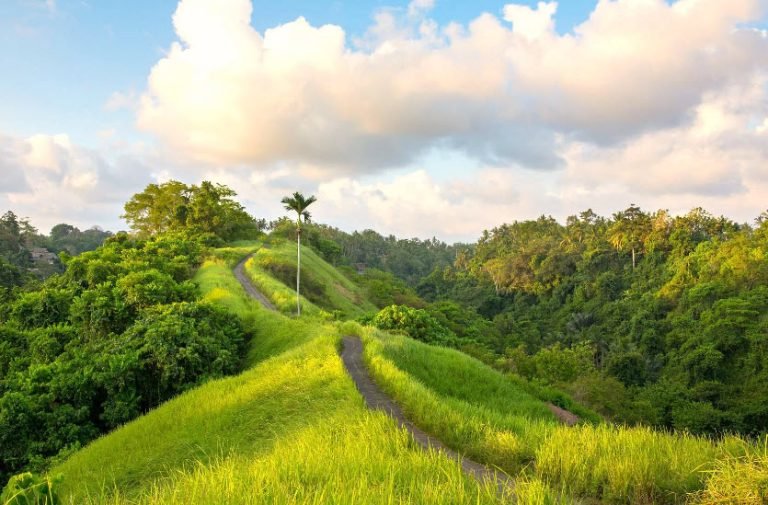Explore the Sacred Monkey Forest Ubud in Bali, Indonesia
Did you know the Ubud Monkey Forest attracts over 10,000 tourists every month? This incredible number shows how loved this sanctuary is. As you walk through, you’ll see hundreds of Balinese long-tailed macaques. They play among ancient paths and tall trees.
The forest covers 12.5 hectares and has at least 100+ tree species. It creates a magical mix of nature, wildlife, and spirituality. The forest conservation area within the Ubud Monkey Forest is crucial for the conservation and management of the natural environment. This place is truly enchanting. The monkey forest area is significant for its sanctified nature, spiritual importance, and diverse monkey population.
The Monkey Forest Ubud Bali is a top spot for tourists. But it’s also important to the local community. It has great cultural and spiritual importance. If you want to feel the peace and beauty of Ubud, places like Villa Amrita Ubud are nearby. They offer a calm place to stay. Visiting this forest is a special chance to connect with nature. It lets you dive deep into Balinese culture.
What to Remember When Exploring the Monkey Forest Ubud:
- The Ubud Monkey Forest is frequented by over 10,000 tourists each month.
- The sanctuary is home to more hundreds (and possibly over a thousand) Balinese long-tailed macaques.
- An expansive 12.5 hectares hosts 186 species of trees.
- The Monkey Forest Ubud Bali holds deep cultural and spiritual significance for locals.
- Accommodations like Villa Amrita Ubud offer a peaceful stay near the sanctuary.
Introduction to the Sacred Monkey Forest Ubud
The Sacred Monkey Forest Ubud lies in the village of Padangtegal, which is viewed as an important spiritual, economic, educational, and conservation center for the village’s residents. It’s a mix of beauty, spirituality, and culture. The forest follows the Balinese Hindu idea of Tri Hata Karana. This philosophy aims to keep harmony among humans, nature, and the spiritual world. The monkey forest’s governing council, managed by the Padangtegal Wenara Wana Foundation, oversees the forest and includes members of the village of Padangtegal.
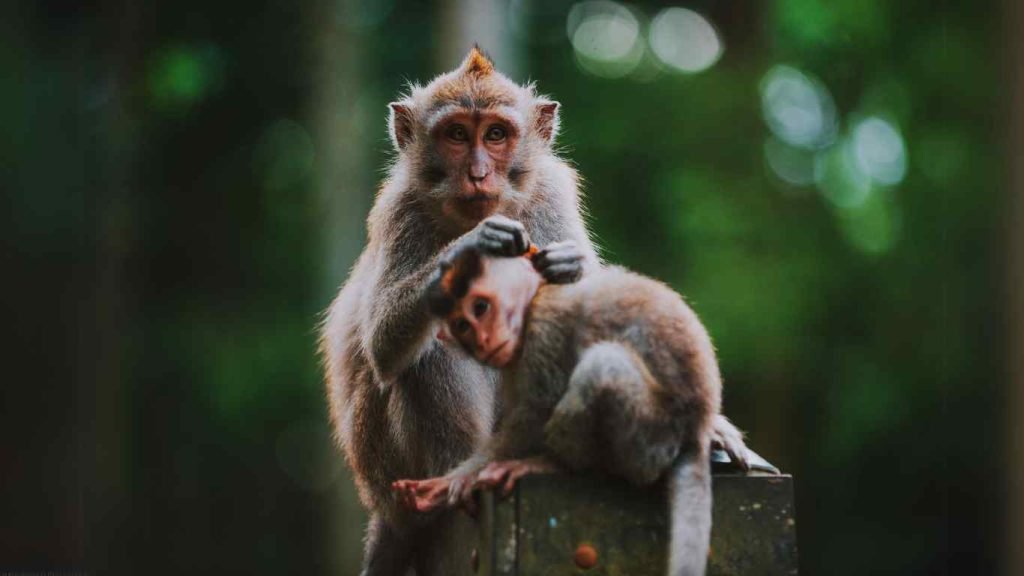
Overview
The forest spans over 12.5 hectares and houses as many as one thousand Balinese long-tailed macaques. The monkey population is split into ten groups, with varying behaviors and interactions with humans. The area is green with hundreds of types of plants and trees, attracting nature enthusiasts. It is said that each month, 10,000 to 15,000 visitors come to the park grounds experience its magic.
History and Cultural Significance
The local community of Padangtegal established it in the 1930s. The Sacred Monkey Forest Ubud offers a blend of spirituality and culture. It has three Hindu temples that are central to locals’ religious activities. These temples also highlight the area’s deep heritage. The monkey forest grounds are home to three Hindu temples constructed around 1350, a forest conservation area, a public hall and gallery, an open stage, a canteen, a first aid center, a police post, parking and toilet facilities, and a composting facility.
A special foundation runs the place, showing Bali’s dedication to preserving sacred traditions. It has educational and conservation efforts. Visitors can walk through trails, passing a deep ravine and a rocky stream. This setup and nature reserve offers peaceful walks by ancient temples.
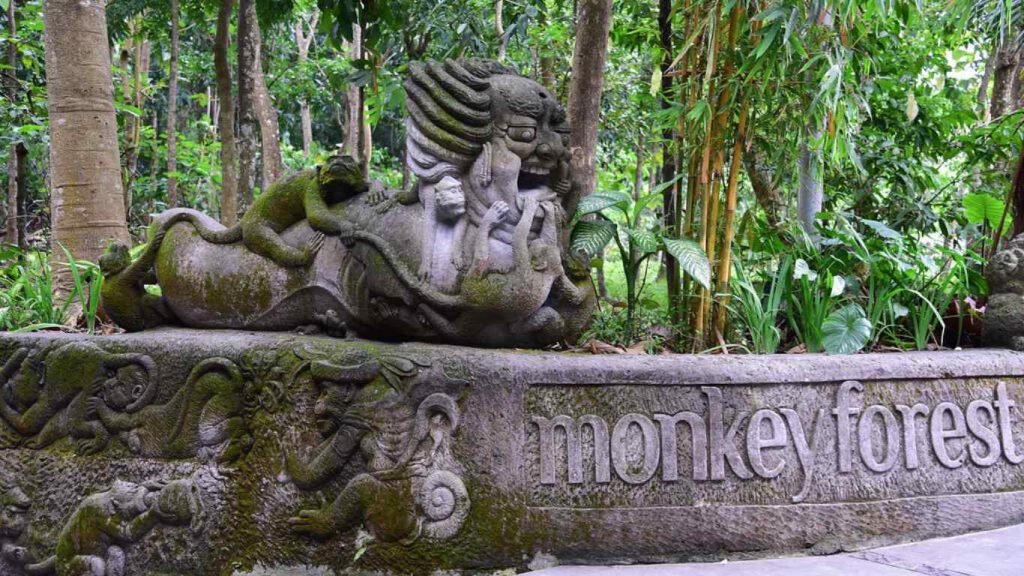
Location and How to Get to the Sacred Monkey Forest Ubud
The Sacred Monkey Forest in Ubud, Bali, is a mesmerizing place located in the village of Padangtegal. You’ll find it at the lower end of Jalan Monkey Forest, in the heart of Ubud.
Exact Location
Just a bit outside or perhaps on the southern edge of Ubud town, you can reach the Monkey Forest quite easily. It’s around 2 kilometers from the town’s center. It’s an easy spot to get to if you’re staying in Ubud, thanks to clear signs that guide the way past numerous shops to this magical forest.
Transportation Options
Looking to visit the Monkey Forest in Ubud? You have a few travel options to consider:
- Walking: If you’re staying close by in Ubud, walking is a wonderful choice. It lets you enjoy the local scene.
- Car or Scooter: Many people choose to rent a car or scooter. There’s plenty of parking available for visitors.
- Taxi: You can also catch a taxi, or use ride-hailing apps like Gojek or Grab. They can take you right to the entrance.
- Bicycle: Biking is a great option for those who prefer to travel green. You can rent bikes in the town for a fast and eco-friendly journey.
After you get there, you’ll find many facilities like temples, an animal clinic, and places to feed the monkeys officially. Remember, it’s key not to bring or conceal any snacks. The monkeys might look for them. The staff works daily to keep visitors safe with various safety measures.
Best Time to Visit Monkey Forest Ubud
The Ubud Monkey Forest is a great spot to explore any time of the year. But picking the right time can make your visit even better. Here’s some advice for your trip planning.
The dry season is usually the better time to go to Monkey Forest Ubud (this is usually best in July and August). During this period, the park’s natural environment is more accessible, allowing visitors to fully appreciate the conservation efforts for rare plants and animals, and observe the social interactions of the humans visiting the park’s monkeys.
Weather Considerations
It is important to know about Bali’s weather. Bali’s wet season runs from November to March. Its dry season is from April to October. The dry season is usually the better time to go to Monkey Forest Ubud. This is because the weather is nicer for being outside, and you’re less likely to get caught in a big rain.
Mornings are great for avoiding crowds. The late afternoon, around 5 PM, has beautiful light for photos.
Peak Tourist Seasons
The Monkey Forest welcomes visitors every day from 8:30 AM to 6 PM. But, it gets really busy during July, August, Christmas, and New Year. To dodge the crowds, try visiting mid-week or outside these busy times. You’ll get to enjoy a peaceful walk through its 30.8 acres.
Unwind at Villa Amrita: Your Oasis in Ubud, Bali!
Escape to Villa Amrita for a slice of paradise in Ubud, Bali – where relaxation and nature intertwine seamlessly.
Monkey Forest Ubud Entrance Fee and Ticket Information
Plan your trip to Monkey Forest Ubud with knowledge of entrance fees and ticket pricing. This is crucial.
Weekday vs. Weekend Pricing
The monkey forest ubud entrance fee changes based on your visit day. As of January 06, 2024, adults pay IDR 80,000 on weekdays and IDR 100,000 on weekends. For kids aged 3 to 12, it’s IDR 60,000 on weekdays and IDR 80,000 on weekends.
Children under three get in free. This makes the forest a perfect spot for families.
Ticket Purchasing Tips
The Monkey Forest Ubud accepts cash, credit cards, and bank cards. This makes it easy for everyone. The ticket counter is open from 09:00 to 17:00 daily. Your ticket lets you explore all day.
Here are some tips to make your visit better:
- Buy your tickets early to skip lines.
- Go on weekdays to save money on the monkey forest ubd ticket price.
- Keep your ticket with you. It lets you into many places like temples and the cemetery.
By paying the monkey forest ubud ticket price, you support conservation. You also help educational programs in the sanctuary. This helps keep the forest alive for future visitors.
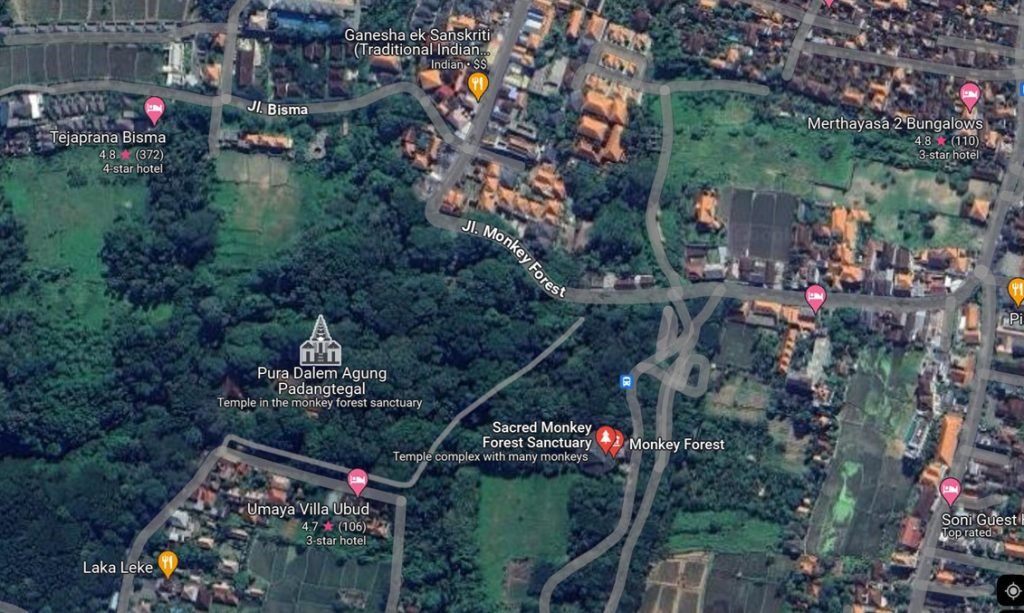
Monkey Forest Ubud Map and Navigation
Exploring the Monkey Forest Ubud is fun with an interactive map. This map makes it easier to walk through the large sanctuary. You’ll enjoy your time more at this amazing place. The Monkey Forest Ubud map points out important spots to visit.
Key Areas to Explore
The Monkey Forest Ubub map shows important sights. Each place lets you see Ubud’s wildlife and culture up close. Highlights include:
- Main Temple: A sacred spot blending forest spirituality with Balinese Hindu traditions.
- Dragon Bridge: An iconic bridge that offers stunning views and photo spots.
- Open Stage: A spot for traditional shows, offering a deep dive into the culture.
- Animal Clinic: Cares for the animals, playing a key part in conservation.
- Compost Facility: Shows sustainable practices, helping keep the forest balanced.
Interactive Map Features
The Monkey Forest Ubub map has easy-to-use tools. You can load the map as a PDF or use a digital locator to find where you are. With these tools, you can easily locate:
- Parking Area: It’s near the entrance, making your visit smooth.
- Conservation Sites: These spots focus on protecting nature and educating about it.
- Cafes and Refreshment Stalls: Perfect for a break and a snack during your visit.
Using the Monkey Forest Ubub map, getting around is easy and fun. It makes your journey through the sanctuary memorable.
Things to Do in Monkey Forest Ubud
The Monkey Forest Ubud has activities that will grab your attention. Watch the lively macaques, look at ancient temples, or take a peaceful nature walk. This sanctuary gives a one-of-a-kind experience.
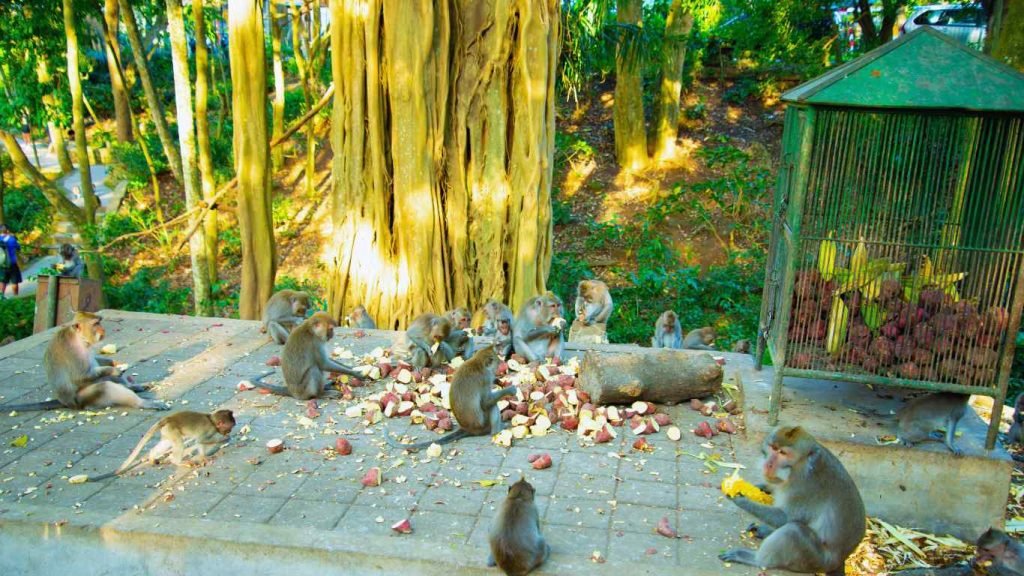
Monkey Watching
Seeing several hundred Balinese long-tailed macaques in their home is a big draw. These fun primates interact with each other and visitors, but be aware of aggressive monkeys that may pose a risk. Be sure to keep an eye on your stuff. Monkeys might grab things like jewelry or glasses. Park personnel carry slingshots to intimidate aggressive monkeys and intervene quickly in confrontations.
Exploring Temples
There are three important Hindu temples here, such as the sacred Pura Dalem Agung. These places let you see Balinese spiritual life and culture. You can’t go inside, but the outside view is worth it. It adds a cultural touch to your trip.
Nature Walks and Trails
The sanctuary covers 30 acres and works to save human health and the forest. It has almost 200 kinds of plants and trees. You can walk on wooden paths and trails, enjoying the quiet place. There are Timor Rusa deer too, making this spot even more special. People usually stay here for 1 to 2 hours to enjoy nature.
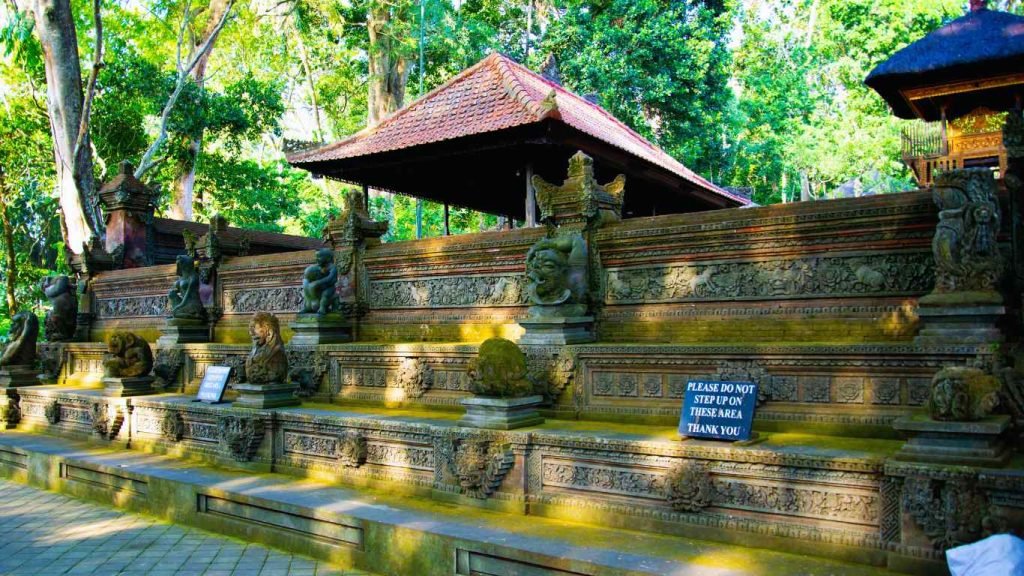
Activity Details: Monkey Watching numerous Balinese long-tailed macaques, observing and exploring Temples – view the sacred Pura Dalem Agung from outside. Nature Walks to stroll along wooden paths amidst dozens of different species of trees
Tips for Visiting the Sacred Monkey Forest Sanctuary
Before you visit the Sacred Monkey Forest Sanctuary, get ready for a fun and safe time. Follow key guidelines to enjoy your visit while keeping both you and the monkeys safe.
Do’s and Don’ts
- Do interact with monkeys only at official feeding stations under staff supervision.
- Avoid touching the monkeys to prevent any aggressive behavior.
- Do follow the advice of the sanctuary staff at all times.
- Leave food, drinks, plastic, or paper bags at the ticket counter—we don’t want to tempt the monkeys!
- Do familiarize yourself with the rules and guidelines of the sanctuary before your visit.
Safety Tips
- If a monkey approaches you, stay calm. Do not run or panic; simply walk away slowly without making direct eye contact.
- Never feed the monkeys external food items like biscuits, nuts, or bread; doing so can lead to harmful behavior.
- Selfies with monkeys are allowed, but staff assistance is required to ensure safety.
- In case of a monkey bite or scratch, seek immediate medical assistance to avoid any potential health risks. Monkey bites can transmit viruses from monkeys to humans, such as the Herpes B virus, and can occur if tourists provoke or try to intimidate the monkeys.
Protecting Your Belongings
- Secure your valuables such as sunglasses and jewelry to prevent loss during your visit.
- It’s advisable to avoid bringing unnecessary items that might attract the monkeys’ attention.
By following these safety tips monkey forest ubud, you ensure a seamless and joyful experience. You’ll protect your well-being and the natural habitat of the monkeys.
Day Adults /Children under 12/Locals/KITAS/KITAP holders and Children under 3 – Weekdays are 80,000 IDR / 60,000 IDR /Free and Weekends 100,000/ IDR 80,000 IDR/ Free.
The Sacred Temples within the Monkey Forest Ubud
The Sacred Monkey Forest Ubud isn’t just a home for lively macaques. It’s also filled with ancient temples. These places show the deep history and spiritual ways of the Balinese people.
Pura Dalem Agung
Pura Dalem Agung is a key temple in the Monkey Forest Ubud. It’s very important for the spiritual life of the locals. You can learn more about it here. The temple, with its beautiful design, is linked to death rituals. Visitors can’t go inside but seeing it from the outside is still meaningful.
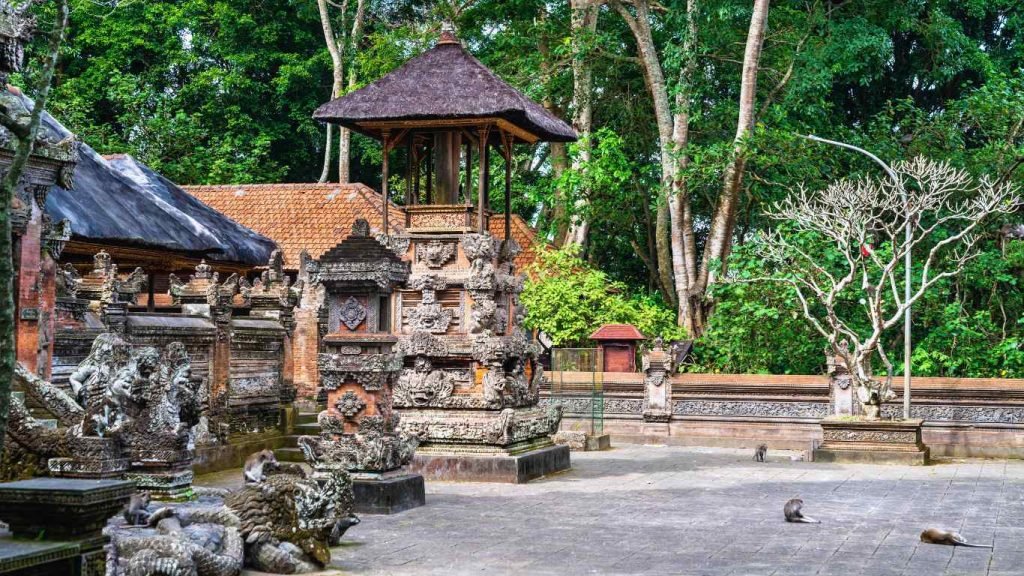
Other Notable Temples
The Monkey Forest Ubud also has other special temples. This includes the Holy Spring Temple and Prajapati Temple. The Holy Spring Temple is known for its water that can purify the soul. It is also referred to as a bathing temple, where people come to conduct spiritual and physical cleansing by bathing in the holy spring. The Prajapati Temple plays a part in community events and personal milestones.
Each temple in the Monkey Forest has its own story. They add to the deep spiritual culture of Balinese Hinduism. These places offer peace and knowledge to all who visit.
Remember, these temples are very important to the people here. By showing respect, you help keep these sacred sites available for others. This way, their important stories can reach future generations.
The Wildlife of Monkey Forest Ubid
The Monkey Forest Ubud is an incredible place bursting with life. Here in the monkey forests, you can see the beauty of nature and learn about Bali’s culture. This huge 10-hectare forest is the home of a wide variety of thriving flora and fauna. These monkeys are also known as crab-eating macaques. They are divided into five groups, each claiming its own area of the park.
Researchers from all over the world come to study these monkeys. They are interested in how the monkeys interact and their complex social lives. This creates a fascinating bond between people and wildlife. However, it is important to remember that these monkeys are wild animals and caution should be exercised when in their proximity.
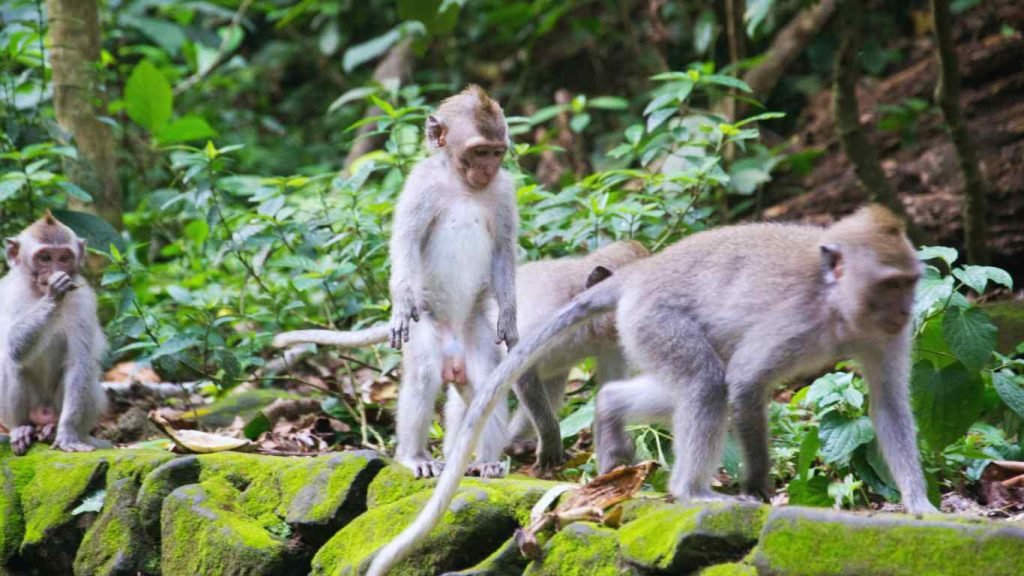
The Long-Tailed Macaques
Visiting the forest, you’ll meet the Balinese long-tailed monkeys. They show both protective and mischievous sides, often approaching human visitors for food and sometimes displaying aggressive behavior if they feel their food offer is being pulled back. This creates a fascinating bond between people and wildlife. In 2011, a study found around 600 or more macaques living here. The group included at least 39 adult males, 38 male sub-adults, 194 adult females, 243 juveniles, and 91 infants. These monkeys are a big part of what makes Monkey Forest Ubud special.
Other Flora and Fauna
Apart from the monkeys, the forest is also a sanctuary for many plants and animals. It has over a hundred types of trees. Some trees are very important to Balinese spiritual practices. The forest is not just a place to visit. It’s where conservation efforts follow the Tri Hita Karana philosophy. This idea focuses on keeping harmony between people, nature, and The Supreme God.
Donations help keep the conservation efforts going. They help conserve rare plants and protect the animals and trees. This preserves the beauty of the forest.
Walking through the forest, you’ll see how the ecosystem flourishes. This is thanks to tourism guidelines that protect its beauty. It ensures that future generations can also enjoy and appreciate this place.

